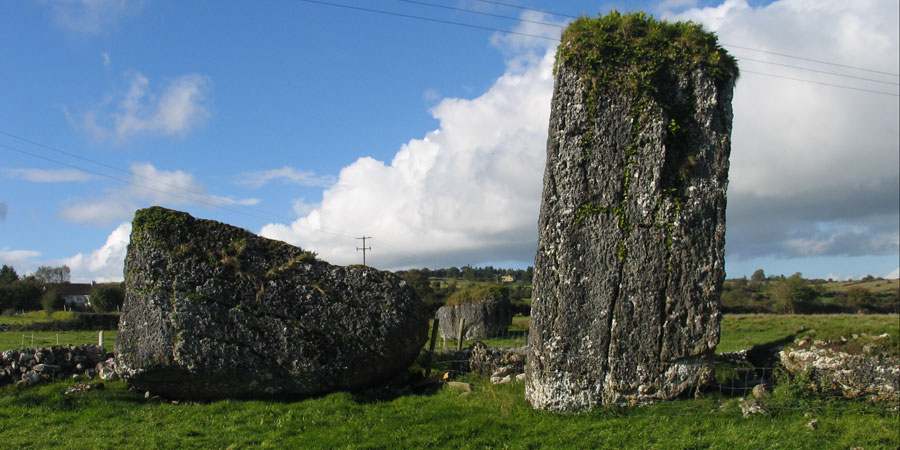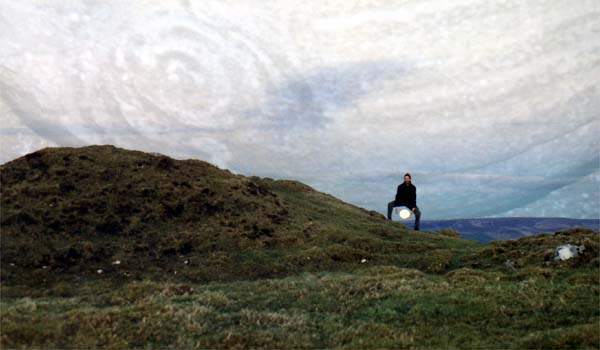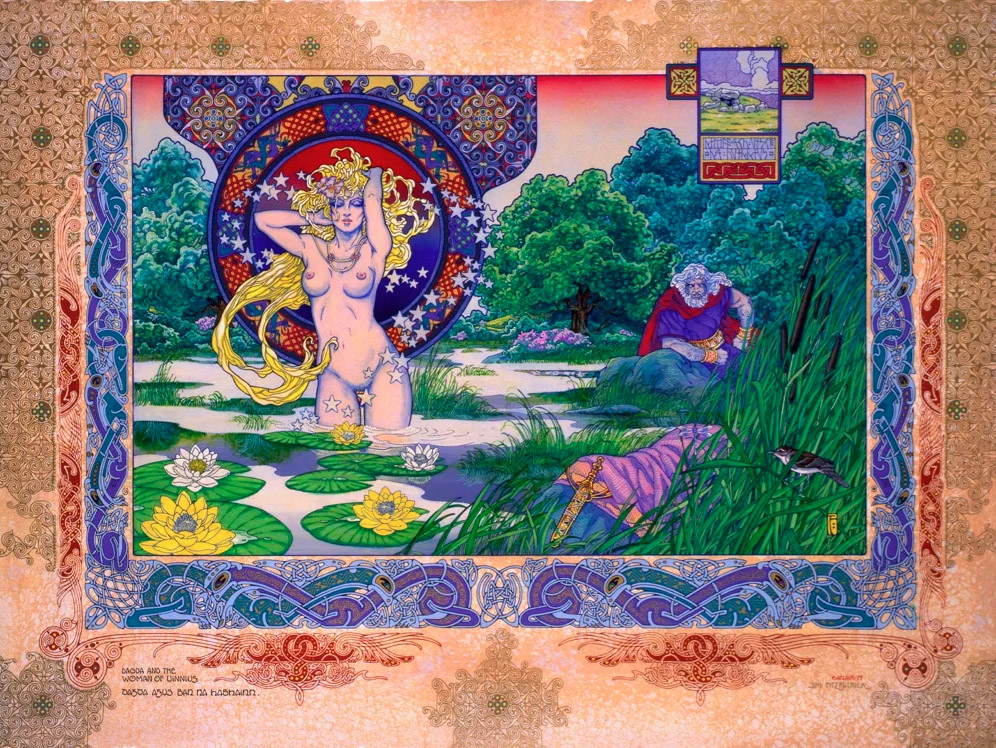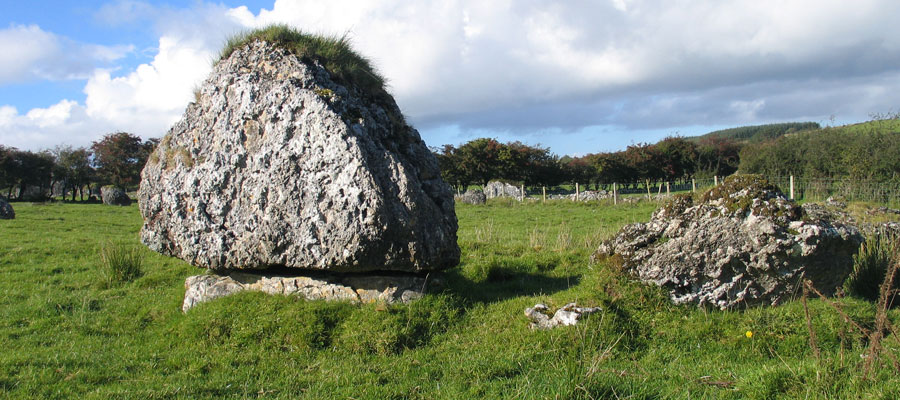A Cast of Characters from Moytura
Source: A Mythic Concordance by Mike Nichols.
Airmed - sister of Miach, she spread her cloak on which to arrange the herbs which sprang from the grave of her murdered brother. But Diancecht, still jealous of Miach, mixed up the herbs, so that no one knows all their right powers to this day. She was the daughter of Diancecht and sister of Octruil, and helped them in their healing work at the well of Slaine.
Aonbharr styled 'of the One Mane', he is Manannan's horse, as swift as the naked cold wind of spring. She can gallop across the sea, and no rider was ever killed off her back. She was often ridden by Lugh.
Angus Og - son of the Dagda, he advised his father how to kill Cridenbel and what reward to ask of Bres. After the second battle of Magh Tuireadh, only four men of the Fomor were left in Ireland, and they were driven out one Samhain night by Morrigu and Angus Og. He was considered for kingship of the Tuatha de Danaan after their defeat. Also called the Frightener or Disturber, for the unrest he occasioned in horses and cattle. His loves included Enghi, Derbrenn, and Caer Ormaith. He was the Irish love-god.

Balor of the Evil Eye.
Balor styled 'of the Evil Eye' or 'of the Strong Blows', he is chief king of the Fomor, husband of Ceithlenn and, by her, the father of Ethlinn. One of his eyes had the power of death in it, so that none could look at it and live, and he also had the power of putting on a different shape. He was also the father of 12 'white-mouthed' sons, all among the chief men of the Fomor. At the second battle of Magh Tuireadh, Lugh made a spear cast that brought Balor's evil eye out through the back of his head, instantly killing him and 27 of his own army, thus fulfilling the prophecy that he would be killed by his grandson.
Balor of the Evil Eye is one of the strangest and most enduring figures to come down to us from the distant past of Ireland. Balor was a Formorian, a race which lived off the west coast of Ireland both on islands and under the sea. Balor was regarded as a wizard king, and lived on Tory Island in the north-west, where he had a great tower. He is said to have gained his Evil Eye in his youth, when he looked through a window where his father's druids were preparing spells. Fumes from the potion went into Balor's Eye, and it became lethal, burning orb capible of obliterating anything that came before it.
Balor was grandfather to the great hero of the Túatha Dé Danann, Lugh of the Long Arm . The conception and birth of Lugh form a part of the manuscript of Moytura. Through a series of actions which begins when Balor robs a magical cow, Lugh is born, survives murder by his grandfather, and is sent to Manannan to be raised in Tir na Nóg.
In fulfilment of an ancient prophecy, Balor dies at the hand of his grandson at the end of the Second Battle of Moytura. Lugh slays Balor in single combat, and the Eye falls out and, burning a great hole in the ground, formed the eerie lake of Lough na Suil, the Lake of the Eye. The story of Balor and Lugh is an archetypal myth that has cropped up in many modern stories; probably the best known version around today is the original Star Wars film, which is largely based on the myth of Moytura. Balor was used as a model for Darth Vader, while Lugh becomes Luke Skywalker and Nuada is the basis for Obe Wan Kenobe. When Luke blows up the Death Star, he is Lugh destroying Balor's Evil Eye.
The myth was also recycled in the Lord of the Rings, though Tolkien was much more subtle. The evil lord Sauron with his one eye is a combination of Balor and Odin. The scene at the beginning of the Fellowship of the Ring which shows the great battle between the elves and men and Sauron's host is a retelling of Moytura. Sauron comes onto the field and kills Gilgaled and Elendil (Balor kills Nuada/ Darth Vader kills Obe Wan). Isildur cutting the ring off Sauron's finger is the equivelant of Lugh taking Balors eye out (Luke destroys the Death Star with his photon torpedo!).
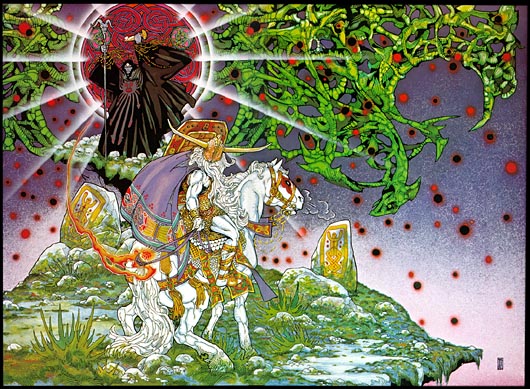
Badb - (Bibe) one of the greatest of the women of the Tuatha de Danaan, she was a battle goddess. She, along with Macha and Morrigu, used powers of enchantment to bring mists , clouds of darkness, and showers of fire and blood over the Firbolgs at Teamhair for three days. Sometimes regarded as the same as Nemain, her name means 'crow' and she could appear in that guise. She was the wife of Net.
Birog - styled 'of the Mountain', a woman-Druid who helped Cian win the love of Ethlinn who had been imprisoned in a tower. When Ethlinn bore a child (Lugh), Balor would have had it killed, but Birog rescued it.
Bres - son of Eri and Elathan, a champion of the Tuatha de Danaan, he was sent to meet Sreng of the Firbolgs. He was the most beautiful of all the young men, and he was chosen king after Nuada. 'As beautiful as Bres' was a common saying. However, he was known for his lack of hospitality, and was deposed when Nuada was reinstated as king. By Brigit, he was father of Ruadan.
Ce - the Druid of Nuada, he was wounded in the second battle of Magh Tuireadh, and when he died and was buried near Carn Corrslebe, a lake burst out over his grave and it was called Loch Ce'.
Corann - Lugh passed through the 'place of the bright-faced Corann' on his way to do battle with Bres.
Corr Slieve na Seaghsa - the Round Mountain of the Poet's Spring, it is a place that Lugh passed on his way to do battle with Bres.
Credenus - styled 'the Craftsman', he was a chief among the Tuatha de Danaan.
Credne Cerd - styled 'the Brazier', a worker in brass for the Tuatha de Danaan.
The Dagda.
Dagda, the - father of Eire, Fodla, Banba, Angus Og, Bodb Dearg, Brigit, Cermait, Ainge and Diancecht. Known as a good builder, he was ordered by Bres to build raths. Styled 'the good god' and 'the Red Man of all Knowledge', he got a dreadful wound from a spear thrown by Ceithlenn in the second battle of Magh Tuireadh and he owned a magic harp called Uaitne. His house was at the Brugh na Boinne, where Dichu was his steward and Len Linfiaclach was the smith. His personal name was Eochaid O'Uathair, and he had a magical club which could slay or heal. Now Lug and the Dagda and Ogma pursued the Fomorians, for they had carried off the Dagda's harper, whose name was Uaitne. Then they reached the banqueting-house in which were Bres son of Elotha and Elotha son of Delbaeth. There hung the harp on the wall. That is the harp in which Dagda had bound the melodies so that they sounded not until by his call he summoned them forth; when he said this below:
Come Daurdabla!
Come Coir-cethar-chuir!
Come summer, Come winter!
Mouths of harps and bags and pipes!
Now that harp had two names, Daur-da-bla "Oak of two greens" and Coir-cethar-chuir "Four-angled music."
Then the harp went forth from the wall, and killed nine men, and came to the Dagda. And he played for them the three things whereby harpers are distinguished, to wit, sleep-strain and smile-strain and wail-strain. He played wail-strain to them, so that their tearful women wept. He played smile-strain to them, so their women and children laughed. He played sleep-strain to them, and the company fell asleep. Through that sleep the three of them escaped unhurt from the Fomorians though these desired to slay them.
Then the Dagda brought with him the heifer which had been given to him for his labor. For when she called her calf all the cattle of Ireland which the Fomorians had taken as their tribute, grazed.
Dianan - one of two witches of the Tuatha De Danaan (the other was Bechulle) who had the power to turn trees and stones and sods of earth into an armed host.
Diancecht - father of Miach, he was a chief among the Tuatha de Danaan, and understood healing. He fashioned an arm of silver for Nuada, who had lost his own in battle. Also father of Octruil and Airmed, he restored slain warriors in the healing well of Slaine. His father was the Dagda and his harper was Corann. Dain Ceacht was the master healer and physician of the Túatha Dé Danann . He is possibly a brother of the Dagda , and also lived at Newgrange at times. He is a very mysterious character, as during a preliminary part of the story, he murders his son, Miach, seemingly jealous of his son's superior skills. Dain Ceacht caused the Well of Slaine to be made at Moytura . This was an enchanted well which contained many healing herbs. Dain Ceacht and three of his children stood about the well casting enchantments into the waters. Any slain or injured warriors who were placed in the well emerged whole and well again, and was able to return to the fighting. This aspect of the myth echoes the stories of the Cauldron of Plenty and the later Holy Grail.
Dolb - the smith of the Fomor.
Donall Donn-Ruadh - styled 'of the Red-brown Hair', he was one of the sons of Manannan. His brothers included Sgoith Gleigeil, Goitne Gorm-Shuileach, and Sine Sindearg. His foster brother was Lugh.
Eas Dara - in west Connacht, it is the harbour where Bres and his army landed in Ireland to battle Lugh.
Eathfaigh - a messenger and tax-gatherer of the Fomor, he was one of the four hardest and most cruel, the other three being Eine, Coron, and Compar.
Echaid - styled 'the Rough', son of Duach, he was foster-father of Lugh.
Eine - a messenger and tax-gatherer of the Fomor, he was one of the four hardest and most cruel, the other three being Eathfaigh, Coron, and Compar.
Elathan (1) - the son of Dalbaech and a king of the Fomor, he was father of Bres by Eri, a woman of the Tuatha de Danaan. He came to her over the sea in a vessel of silver, himself having the appearance of a young man with yellow hair, wearing clothes of gold and five gold torcs.
Elathan (2) - son of Lobos, he was one of the Fomor who took part in the Second Battle of Magh Tuireadh.
Elathan (3) - son of Delbaeth, he was one of the Fomor who took part in the Second Battle of Magh Tuireadh.
Eri - a woman of the Tuatha de Danaan, the daughter of Delbaith, she was mother of Bres by Elathan, a king of the Fomor. She was the wife of Cethor.
Ess Dara - near Magh Tuireadh-2.
Findgoll - son of Findemas, a Druid who advised Nechtan in the deceiving of King Bres.
Gairech - one of two hills (the other being Ilgairech) that Lugh passed on his way to do battle with Bres.
Gamal - son of Figal, he was one of the two door-keepers at Teamhair when Lugh first arrived.
Garbhan - he and Imheall were the Dagda's two builders, and they built the rath around the grave of Aedh, called the Hill of Aileac.
Glas Gaibhnenn - (Glos Gov-nan) belonging to Cian, she was a wonderful cow whose milk never failed.
Goibniu - styled 'the Smith', the son of Tuirbe,and brother of Cian and Samthainn, he was a chief among the Tuatha de Danaan, and lived at Druim na Teine. His ale kept whoever tasted it from age and from sickness and from death.
Goll - one of the Fomor who took part in the Second Battle of Magh Tuireadh.
Grellach Dollaid - also called 'the Whisper of the Men of Dea', it is the place where Lugh, Nuada, the Dagda, Ogma, and Diancecht made their secret plans to rise against the Fomor.
Hall of the Morrigu - in the house of the Dagda at the Brugh na Boinne.
Hill of Dabilla - a hill near the house of the Dagda at Brugh na Boinne.
Indech - son of De Domnann and father of Octriallach, he was a king of the Fomor who fell and was crushed in the Second Battle of Magh Tuireadh.
Ingol - one of the Fomor who took part in the Second Battle of Magh Tuireadh.
Island of the Tower of Glass - Balor lived there in the days the Fomor visited Ireland often. From this island, the Fomor would capture ships that passed near. They thus defeated the ships of the sons of Nemed in a time before the Firbolgs were in Ireland.
Islands of Mod - islands from which Ogma was ordered by Bres to bring firing every day.
Rath Brese - the Dagda made a trench around it.
Liath - son of Lobais, he was one of the chief men of the Fomor.
Lobais - styled 'the Druid', he was father of Liath and one of the chief men of the Fomor.
Luath - two swift men of the Fomor were named Luath, and they gathered an army for Bres when he went to do battle with Lugh.

